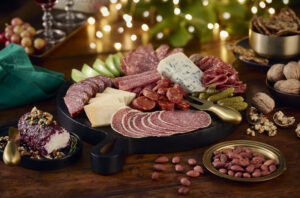Tips To Create a Well-Balanced Charcuterie Board
October 1, 2021 | Entertaining
The great appeal of a charcuterie board is that it’s relatively simple to throw together. You can prepare it in advance to have it waiting as your guests trickle in, or you can make it appear magically after dinner like some sort of culinary Houdini.
At its most basic form, the charcuterie spread was a lunch for farmers and hunters. A hard wedge of cheese and a dry-cure sausage, like a landjaeger, were perfect for carrying around and could easily be turned into a meal with a chunk of bread and their ubiquitous folding knives. But today, we’d like to share some of our charcuterie board ideas that will help you to elevate the humble meat and cheese platter into an art form that will wow your guests and thrill your taste buds.
THE THREE ELEMENTS OF CHARCUTERIE
Before we get into which cheeses to choose or which meats you should order, let’s first look at the three elements you should consider when putting together your charcuterie board. You want to make sure you achieve a balance of flavours, textures, and colours.
FLAVOURS
A rave-worthy charcuterie board offers a mix of flavours so that there is something that caters to different tastes but also so that each mouthful offers a new experience to the person who samples from the entire platter. Obviously, the larger your platter the more flavours you can bring out, but let’s start with the basics first: salty, savoury, and sweet.
Salty is easy to find. Chances are, all the meats you choose will have been cured using salt, although some will keep a salty taste more than others. Some ways to add salty flavours to your charcuterie board are cured meats like salami, landjaeger, pepperoni or bresaola; cheeses such as pecorino, Manchego, or asiago; and some sundried tomatoes, nuts, or crackers.
Savoury is, admittedly, a wide category. We use it to include everything from earthy, to tangy and smoky. So, even with your savoury choices, try to find a variety. Starting with the earthiness, you’ll find this in a lot of cheeses, from camembert to Swiss cheeses, as well as nuts, fruits, or chutneys. For the savoury tang, our go-to is a dry-cure salami, like a Cervelat or an Italian Wine Salami; and we get smokiness from an applewood smoked cheddar or a Hungarian Salami.
Some people are surprised to find sweet treats on a charcuterie platter, but fruits, candied nuts, toffees, and jams serve multiple purposes. Firstly, they make a great palate cleanser between savoury bites; they’re a fantastic complement to some of the saltier offerings (you can’t go past figs wrapped in prosciutto or a sharp cheddar with quince jelly); and lastly, a few scattered sweets around the platter are like hidden treasures to the sweet-tooth’s, vegan and vegetarians among your guests.
A couple of other tastes to bear in mind to really elevate your board are spice and acidity. You don’t need too much spice but a Pepper Salami or a Monterey Jack with Jalapeño provides a nice kick for those who like spicier foods. Or think about a red chili jelly so that they can make every mouthful hot. Pickles, relishes, and mustards let your guests adjust the acidity for themselves. Thinking about serving some particularly if you have fattier meats or creamier cheeses.
TEXTURES
As with the flavours, you want to find a balance of crunchy versus creamy, and firm versus smooth. Your crunchy elements might include crackers, nuts, or cornichon. Creaminess could be found with a double cream brie, moderately firm salamis with a fatty mouth-feel, or a pâté de foie. For the firm bite that gives your teeth something to hold onto, think about some of the harder cured meats (like pepperoni sticks or slices of landjaeger), hard cheeses like a Comte or a Tomme, some dried fruit, or pieces of farmhouse bread. Add a little smoothness with some pestos and dips, spreadable cheeses, or fresh fruits.
COLOURS
This is arguably the least important of the three elements however, making sure you have a balanced colour palate not only makes your charcuterie board pleasing to the eye, it also serves as a generally cheat sheet to make sure you’ve got the flavour balance right (pink and reds tend to be salty, yellows and whites bring some savoury earthiness and the brighter colours provide a pop of sweet.

ADDITIONAL TIPS AND TRICKS
GARNISHES
The first and only rule of garnishes is that they should be edible and they should complement the dish. Easy garnishes that tick both those boxes are fresh fruit (think green grapes or sliced nectarines), fresh herb leaves (soft leaves like basil or cilantro are preferable to rosemary), or, if you want to get fancy, a few edible flowers or candied rose petals.
LABELS
If your charcuterie board is for a small social gathering (or it’s a small board) talking to your guests about the types of cheeses can easily be part of the conversation. For bigger events and boards, it’s a great idea to have little labels so that people know what they’re eating.
SLICING
Cheeses and charcuterie are best served at room temperature, this allows the flavours to come out and the textures to soften. However, slicing cheeses at meats at room temperature is less than ideal and normally leads to an unappealing mess. Make it easy for yourself and your guests by slicing your salami and cheeses straight out of the fridge (while they’re still firm) before you plate up.
Guten Appetit.

